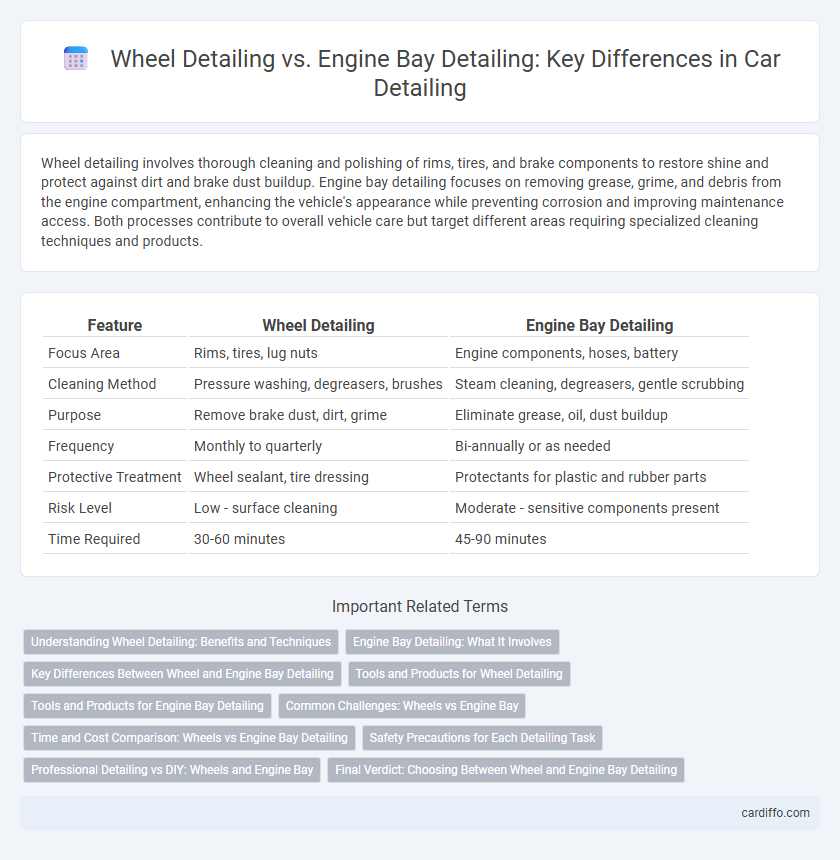Wheel detailing involves thorough cleaning and polishing of rims, tires, and brake components to restore shine and protect against dirt and brake dust buildup. Engine bay detailing focuses on removing grease, grime, and debris from the engine compartment, enhancing the vehicle's appearance while preventing corrosion and improving maintenance access. Both processes contribute to overall vehicle care but target different areas requiring specialized cleaning techniques and products.
Table of Comparison
| Feature | Wheel Detailing | Engine Bay Detailing |
|---|---|---|
| Focus Area | Rims, tires, lug nuts | Engine components, hoses, battery |
| Cleaning Method | Pressure washing, degreasers, brushes | Steam cleaning, degreasers, gentle scrubbing |
| Purpose | Remove brake dust, dirt, grime | Eliminate grease, oil, dust buildup |
| Frequency | Monthly to quarterly | Bi-annually or as needed |
| Protective Treatment | Wheel sealant, tire dressing | Protectants for plastic and rubber parts |
| Risk Level | Low - surface cleaning | Moderate - sensitive components present |
| Time Required | 30-60 minutes | 45-90 minutes |
Understanding Wheel Detailing: Benefits and Techniques
Wheel detailing enhances vehicle aesthetics and safety by thoroughly cleaning brake dust, grime, and road contaminants from rims, tires, and lug nuts. Effective techniques include using specialized brushes, pH-balanced cleaners, and sealants to restore shine, prevent corrosion, and improve tire longevity. Regular wheel detailing not only boosts curb appeal but also extends the lifespan of wheels and associated components.
Engine Bay Detailing: What It Involves
Engine bay detailing involves thoroughly cleaning and restoring the engine compartment, targeting components such as the engine block, battery, hoses, and wiring to remove grease, dirt, and grime. This process uses specialized degreasers, brushes, and sometimes steam to ensure a deep clean without damaging sensitive parts. Proper engine bay detailing enhances the vehicle's appearance, helps identify leaks or worn parts, and can improve overall engine performance by maintaining a cleaner environment.
Key Differences Between Wheel and Engine Bay Detailing
Wheel detailing primarily targets brake dust, road grime, and tire conditioning to restore shine and protect against corrosion, while engine bay detailing focuses on degreasing, cleaning electrical components, and enhancing overall engine aesthetics. Wheel detailing often requires specialized brushes and wheel-specific cleaners to effectively remove tough contaminants, whereas engine bay detailing necessitates careful use of water-resistant products and protective coatings to prevent damage. Both processes prioritize meticulous cleaning, yet differ significantly in approach and materials due to their unique functional and exposure characteristics.
Tools and Products for Wheel Detailing
Wheel detailing requires specialized tools such as a variety of brushes including lug nut brushes, tire brushes, and wheel woolies to effectively clean tight spaces and brake dust buildup. High-quality wheel cleaners, rim protectors, and tire dressings are essential products that enhance the cleaning process and restore the shine and protection of wheels. In contrast, engine bay detailing focuses on degreasers, plastic and rubber conditioners, and soft brushes designed to safely clean delicate engine components without causing damage.
Tools and Products for Engine Bay Detailing
Engine bay detailing requires specialized tools such as soft-bristle brushes, microfiber towels, and precision spray bottles to safely clean delicate components without causing damage. High-quality degreasers and engine-safe cleaners are essential for removing grime and oil buildup while protecting sensors and electrical parts. Using protective coatings and water-resistant sealants enhances the longevity of the clean surface and prevents rust and corrosion within the engine bay.
Common Challenges: Wheels vs Engine Bay
Wheel detailing often faces challenges such as removing stubborn brake dust, dirt buildup in tight crevices, and preventing damage to alloy finishes. Engine bay detailing requires careful attention to delicate electrical components, avoiding water intrusion, and effectively degreasing heavy oil and grime deposits. Both areas demand specialized cleaning techniques and products to ensure thorough, safe results without compromising vehicle parts.
Time and Cost Comparison: Wheels vs Engine Bay Detailing
Wheel detailing typically requires less time and lower cost compared to engine bay detailing, as it involves cleaning and protecting exposed surfaces like rims and tires. Engine bay detailing demands more intensive labor, specialized cleaners, and careful handling to avoid damaging sensitive components, resulting in higher expenses. The average wheel detailing session takes about 30 to 45 minutes and costs between $50 and $100, whereas engine bay detailing often requires 60 to 90 minutes and ranges from $75 to $150.
Safety Precautions for Each Detailing Task
Wheel detailing requires careful handling of brake dust and strong chemical cleaners, so wearing protective gloves and eye protection is essential to prevent skin irritation and eye injury. Engine bay detailing necessitates avoiding electrical components and using plastic covers or tape to protect sensitive parts, alongside wearing a mask to avoid inhaling chemical fumes. Both tasks demand working in a well-ventilated area to ensure safety and prevent hazardous exposure.
Professional Detailing vs DIY: Wheels and Engine Bay
Professional wheel detailing uses specialized brushes and high-pressure washers to remove brake dust, grime, and contaminants, preserving the finish and preventing corrosion more effectively than most DIY methods. Engine bay detailing by experts involves careful degreasing with safe, non-corrosive cleaners and controlled rinsing to avoid electrical damage, which can be challenging to replicate with DIY approaches. Choosing professional detailing ensures thorough cleaning and protection in both wheels and engine bays, maximizing vehicle appearance and longevity.
Final Verdict: Choosing Between Wheel and Engine Bay Detailing
Choosing between wheel detailing and engine bay detailing depends on your vehicle's condition and your maintenance priorities. Wheel detailing enhances curb appeal by removing brake dust and grime, improving the overall look and performance of tires and rims. Engine bay detailing focuses on functionality by cleaning grease and debris, helping to prevent mechanical issues and maintain engine efficiency.
Wheel Detailing vs Engine Bay Detailing Infographic

 cardiffo.com
cardiffo.com